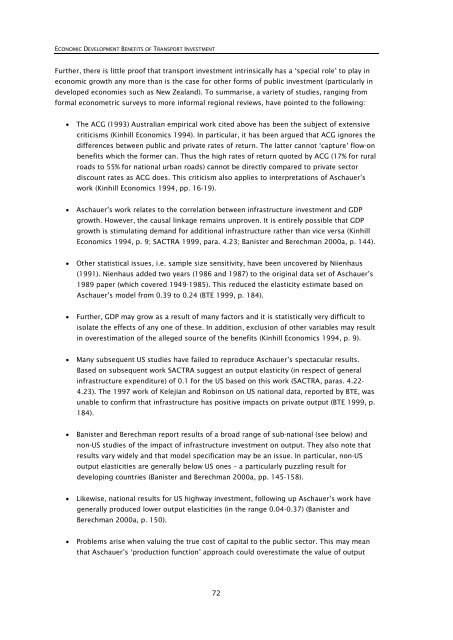Research 350 - NZ Transport Agency
Research 350 - NZ Transport Agency
Research 350 - NZ Transport Agency
You also want an ePaper? Increase the reach of your titles
YUMPU automatically turns print PDFs into web optimized ePapers that Google loves.
ECONOMIC DEVELOPMENT BENEFITS OF TRANSPORT INVESTMENT<br />
Further, there is little proof that transport investment intrinsically has a ‘special role’ to play in<br />
economic growth any more than is the case for other forms of public investment (particularly in<br />
developed economies such as New Zealand). To summarise, a variety of studies, ranging from<br />
formal econometric surveys to more informal regional reviews, have pointed to the following:<br />
• The ACG (1993) Australian empirical work cited above has been the subject of extensive<br />
criticisms (Kinhill Economics 1994). In particular, it has been argued that ACG ignores the<br />
differences between public and private rates of return. The latter cannot ‘capture’ flow-on<br />
benefits which the former can. Thus the high rates of return quoted by ACG (17% for rural<br />
roads to 55% for national urban roads) cannot be directly compared to private sector<br />
discount rates as ACG does. This criticism also applies to interpretations of Aschauer’s<br />
work (Kinhill Economics 1994, pp. 16-19).<br />
• Aschauer’s work relates to the correlation between infrastructure investment and GDP<br />
growth. However, the causal linkage remains unproven. It is entirely possible that GDP<br />
growth is stimulating demand for additional infrastructure rather than vice versa (Kinhill<br />
Economics 1994, p. 9; SACTRA 1999, para. 4.23; Banister and Berechman 2000a, p. 144).<br />
• Other statistical issues, i.e. sample size sensitivity, have been uncovered by Niienhaus<br />
(1991). Nienhaus added two years (1986 and 1987) to the original data set of Aschauer’s<br />
1989 paper (which covered 1949-1985). This reduced the elasticity estimate based on<br />
Aschauer’s model from 0.39 to 0.24 (BTE 1999, p. 184).<br />
• Further, GDP may grow as a result of many factors and it is statistically very difficult to<br />
isolate the effects of any one of these. In addition, exclusion of other variables may result<br />
in overestimation of the alleged source of the benefits (Kinhill Economics 1994, p. 9).<br />
• Many subsequent US studies have failed to reproduce Aschauer’s spectacular results.<br />
Based on subsequent work SACTRA suggest an output elasticity (in respect of general<br />
infrastructure expenditure) of 0.1 for the US based on this work (SACTRA, paras. 4.22-<br />
4.23). The 1997 work of Kelejian and Robinson on US national data, reported by BTE, was<br />
unable to confirm that infrastructure has positive impacts on private output (BTE 1999, p.<br />
184).<br />
• Banister and Berechman report results of a broad range of sub-national (see below) and<br />
non-US studies of the impact of infrastructure investment on output. They also note that<br />
results vary widely and that model specification may be an issue. In particular, non-US<br />
output elasticities are generally below US ones – a particularly puzzling result for<br />
developing countries (Banister and Berechman 2000a, pp. 145-158).<br />
• Likewise, national results for US highway investment, following up Aschauer’s work have<br />
generally produced lower output elasticities (in the range 0.04-0.37) (Banister and<br />
Berechman 2000a, p. 150).<br />
• Problems arise when valuing the true cost of capital to the public sector. This may mean<br />
that Aschauer’s ‘production function’ approach could overestimate the value of output<br />
72
















